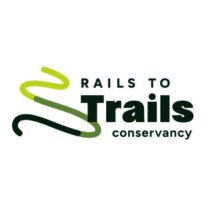Rails-to-Trails Conservancy and Major Partners in Cleveland Release Study And Recommendations for Enhancing Citywide Bike Connectivity Options

FOR IMMEDIATE RELEASE:
April 11, 2019
CONTACT:
Patricia Brooks, patricia@matchmapmedia.com, 202.351.1757
Rails-to-Trails Conservancy and Major Partners in Cleveland Release Study And Recommendations for Enhancing Citywide Bike Connectivity Options
55% of Cleveland residents have access to bike transportation methods; analysis shows how to increase that number to 82% with strategic investment
CLEVELAND—At a press conference on April 11, Rails-to-Trails Conservancy (RTC) and Bike Cleveland released “Advancing Cleveland’s Active Transportation Agenda,” showing how the city could increase the number of people who have access to biking connectivity from 55% to 82%.
The recommendations are the results of how the city fared in a recent BikeAble™ analysis, conducted by RTC in 2018 in collaboration with the City of Cleveland, Bike Cleveland and other local partners, to explore the residents’ current and potential future safe access to low-stress biking routes, and to identify the benefits a targeted investment in biking facilities could bring citywide. The BikeAble findings reveal a roadmap for increased transportation access to key local destinations, such as workplaces, schools, transit stops and shopping centers. The ideal routes would be low stress—meaning away from traffic as much as possible and safer to navigate.
“The majority of Cleveland’s trips fall within a bike-friendly distance. But nearly half of residents do not have the ability to travel by bike under the current design,” said Eric Oberg, RTC’s midwest director of trail development. “The chief deterrent to biking is traffic stress, so our study identifies options for how we can lower that stress.”
Traffic stress is greatly determined by the speed of motorists and the number of lanes on the road. Areas with high speeds and many lanes are more stressful to cyclists. Lower traffic speeds, lower traffic volumes and physical separation of bicyclists from other traffic are just some options for improving bike connectivity.
The Cleveland Bikeway Master Plan calls for expanding the city’s bike network to provide more infrastructure that connects residents to all major destinations: jobs, schools, shopping, and parks and recreation amenities. BikeAble analyzes a city’s existing network of roads and trails to determine its level of low-stress connectivity. The tool also assesses the full future build-out of all planned bicycling projects.
Moving forward, the analysis will assist the city in determining which projects could be prioritized for maximum connectivity. Upon its completion, licensure of the BikeAble tool and a comprehensive training for partners was conducted to ensure that Cleveland’s public agencies and advocates have the power of BikeAble at their fingertips to implement smart, equitable and effective bicycle-facility project development. By comparing existing and future conditions, planners can see the extent to which planned projects will contribute to low-stress connectivity for residents throughout the city.
“Access to safe and inviting transportation opportunities are a civil right and essential to quality of life and economic growth in Cleveland,” said Deltrece Daniels, Bike Cleveland’s outreach and membership manager. “Since Bike Cleveland started in 2012, bike ridership increased by 86%, and with studies like BikeAble Cleveland, we will only continue to grow.”
Multiple local partners participated in the analysis through a steering committee, including: Bike Cleveland, the City of Cleveland Planning Commission, UH Bikes, Cleveland Metroparks, the Northeast Ohio Areawide Coordinating Agency, the RTA Cuyahoga County Planning Commission and the Cleveland Metropolitan Housing Authority.
As part of a larger effort to connect residents beyond the metro region, Cleveland is serving as the regional hub for the Industrial Heartland Trails Coalition (IHTC), a 1,500-miles-plus multiuse trail network that—when complete—will provide a safe, seamless walking and biking route linking 51 counties in four states: Pennsylvania, West Virginia, Ohio and New York. During the press conference, a new video was released highlighting the value of the IHTC network for tourism and economic revitalization.
The BikeAble analysis highlights the city’s trail network potential ahead of RTC’s seventh annual Opening Day for Trails, a national kickoff for the spring trail season. Two days after the press conference, on April 13 at 11 a.m. Eastern, media are invited to join RTC, Bike Cleveland, Cuyahoga Greenway Partners, Cleveland Metroparks and other outdoor enthusiasts and trail lovers for a fun event on the Cuyahoga River to showcase the benefits that trails deliver to the region. Full details can be found on RTC’s Cleveland Opening Day Facebook event page.
RTC’s BikeAble tool is a customizable GIS-modeling platform for analyzing the bicycle connectivity of a community to determine the best low-stress routes for bicycling. BikeAble in Cleveland was made possible by the support of the Cleveland Foundation and The George Gund Foundation with special thanks to the BikeAble Steering Committee.
Rails-to-Trails Conservancy is the nation’s largest trails organization—with a grassroots community more than 1 million strong—dedicated to connecting people and communities by creating a nationwide network of public trails, many from former rail lines. Connect with RTC at railstotrails.org and @railstotrails on Facebook, Twitter and Instagram.

Donate
Everyone deserves access to safe ways to walk, bike, and be active outdoors.
